
Understanding the Return of 30-Year Fixed Rates to 6.50%
The mortgage landscape is once again witnessing a notable shift as 30-year fixed rates return to 6.50%, a threshold not seen since October 2024. This development, reflecting broader economic trends, raises crucial questions about affordability, home purchases, and market stability. With varying rates reported by different sources, understanding how these fluctuations impact both prospective buyers and existing homeowners is vital.
The Nuances Behind Mortgage Rate Statistics
While Freddie Mac's conventional survey reports a rate of 6.56%, it lags in real time, often reflecting outdated conditions. On the contrary, Mortgage News Daily tracks daily shifts in rates, illustrating the market's volatility in real-time. The 6.50% average reported recently results from a combination of various factors, including recent remarks by Fed Chair Jerome Powell, affecting investor confidence and market activity. As these indices fluctuate, prospective homeowners must stay vigilant to the nuances of rates depending on credit scores and down payment options.
The Context: Why 6.50% Matters in Today's Market
At face value, a 6.50% interest rate might seem a minor detail, but it's emblematic of broader economic trends affecting the housing market. This competitive average reflects what many homebuyers may encounter assuming favorable conditions such as a well-above-average credit score and significant down payment. For sellers, understanding the implications of these rates on buyer affordability is critical in positioning their properties competitively in an evolving market.
This Moment as a Historical Benchmark
Historically, interest rates have cycled through highs and lows. The shift back to 6.50% signals a period where rates stabilize, potentially attracting more buyers hesitant about entering the market amidst higher rates in previous months. This return to a lower rate might suggest a turning point, possibly invigorating the housing market as buyers reassess their options. Keeping an eye on the historical context of these numbers allows informed decision-making for both consumers and real estate investors.
Potential Impacts for Homebuyers and Investors
Current homeowners seeking to refinance or potential buyers considering their first home must weigh the implications of re-entering a market with rates returning to a familiar average. With interest rates affecting monthly payment calculations, understanding the direct impact on overall purchase power is crucial. Additionally, investors eyeing rental properties may find that changes in the lending landscape reshape their financial strategies as affordability becomes a pressing issue.
Looking Ahead: What to Expect in the Future
As we look to the future, it’s essential to remain informed about economic indicators that influence mortgage rates, such as inflation trends and monetary policy. Should economic conditions improve, we could witness further reductions in mortgage rates, providing opportunities for both first-time and seasoned buyers. Alternatively, instability in the market can spark rapid increases, necessitating a cautious approach for would-be buyers.
Concluding Thoughts on Mortgage Rates and Market Dynamics
The return of the 30-year fixed rates to 6.50% is more than just a number; it signifies ongoing adjustments in the real estate market shaped by varied socioeconomic factors. Homebuyers must not only track rates but also adapt financial strategies that align with their long-term housing goals. With mortgage decisions being among the most significant financial commitments, this is a crucial period of re-evaluation for both consumers and investors alike.
As our understanding of rates and their implications continues to evolve, leveraging comprehensive resources and insights can lead to smarter decisions in the housing market.
 Add Row
Add Row  Add
Add 




Write A Comment